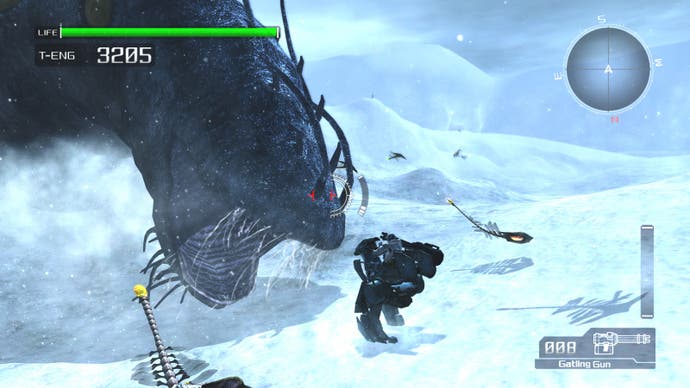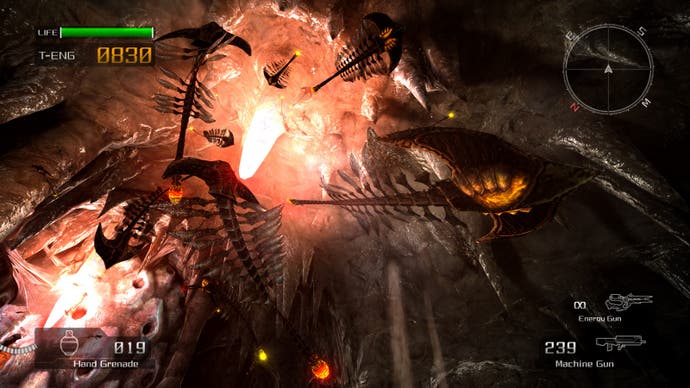Lost Planet: Extreme Condition
Fountains of Wayne.
When we shoot things in videogames, we almost expect the downed foe to leave something shiny behind for us to pick up. It's practically a gaming law, with some of them designed to take advantage of our curious obsessive-compulsive desire to hoard thousands of pointless artefacts like the thieving digital magpies that we are. How many times have we gone back to games we've already finished, just to make sure we've hoovered up every last orb/crystal/coin/whatever? It's the first sign of madness, I tells ya.
Lost Planet, mind you, goes about it another way. It basically reverse engineers the whole premise of Dead-Things-Must-Spew-Shiny-Stuff to the point where Capcom has conjured an entire storyline to justify said spewage. Anyway, it made me smile, so I'm going to share it with you. Basically, in The Future, a bunch of pesky humans decide to colonise a hostile frozen planet (called E.D.N. III) inhabited by giant insect-like creatures called the Akrid. Cunningly, the Akrid house precious thermal energy (T-ENG) within their bodies, and the humans soon realise that they can utilise this energy resource to help them survive the sub-zero temperatures. Simple plan? Shoot Akrid, harvest the thermal orange ooze, stay alive.
Dressed in the rather handy Vital Suit, the game's protagonist (the chiselled Wayne) can brave the icy wasteland by going on an Akrid killing spree, knowing full well that every giant bug he kills tops up his T-ENG. Handy. But he's got a reason for that, too. Apparently an Akrid named 'Green Eye' (can't imagine why...) killed his father, so now he's seeking good old-fashioned retribution. So, with the slaughter and the orange ooze fully justified, what of the game?
Wayne VS the world

Unusually for Capcom, Lost Planet strips away many of the layers that characterise the games it is renowned for; layers which would have arguably made this game a more unique and interesting prospect. So, what we're served up with is an often spectacular looking third-person shooter with a smidgen of generally-exciting-but-not-especially-taxing survival-combat built-in, and an increasing focus on VS mech combat, but more of that later.
Built around a linear level-by-level structure, you're never in any doubt what to do in Lost Planet, given that there's one main goal of each of the 11 levels: destroy everything you see. For the bulk of each level, you'll focus firmly on a series of close encounters with the Akrid threat - potentially an endless series of encounters until you locate and eliminate the nests that they pour out of. Along the way you'll also encounter larger, well armoured Akrid which often bowl towards you, knock you off your feet and do their best to sap your energy any way they can, and at the climax of every level is an even bigger foe to finish off.
But unlike so many challenging Capcom games down the years, Lost Planet always seems to offer you, the player, the edge in combat. The general 'grunts', be they of Akrid or of human origin, don't offer up a huge amount of resistance. With fairly forgiving (and often plain dumb) AI routines, plenty of ammo, stacks of health and powerful weaponry at your disposal, you continually carve a swathe through dozens of foes that offer up little resistance (particularly the humans), mindfully collecting all the orange ooze they leave behind and remembering to pick up the discarded weapons and ammo as you go. And even when faced with the mini bosses and typically spectacular screen-filling end-of-level bosses, their weak spots are generally so obvious that once you've worked out their predictable attack patterns the fight is over pretty quickly. A few well-aimed clips, a few wisely saved rockets and their health bar plummets. Sooner than you imagine, the fight is over and it's on to the next series of encounters.
Mech assault

Amidst all the on-foot combat you'll also come across discarded VSs, allowing you to crush bigger Akrid with ease with your dual mounted weaponry (which you can swap as you come across other weapons left lying around), as well as fight it out toe-to-toe with other mechs prowling the icy landscapes and abandoned structures. Better still, being strapped inside a mech gives you an extra layer of protection from the splash damage of the explosive rockets and so on being aimed at your HEAD, meaning your ever-depleting T-ENG stands a chance of lasting a little longer than usual. That said, your shield energy is pretty flimsy, so you'll constantly be doing a dance of death, ejecting from stricken craft and legging it to the nearest abandoned VS - or simply legging it.
In doing exactly that (legging it, that is), you begin to expose some of the limitations to the level design within Lost Planet, because the game regularly lets you get away with lazily running through entire sections of the game without even bothering to take down your enemies. In fact, in one memorable level featuring a giant worm (ripped straight from Dune, evidently), you're positively encouraged to run the gauntlet or else you'll get battered to death repeatedly, forced to start right from the beginning. In isolation that's fair enough, but it's also apparent that other levels let you get away with doing the same thing - and doing so can often prove the best tactic, or else you might end up needlessly facing the same respawning gits over and over, running down both your T-ENG and your best weapons. You can condone respawning enemies when it's up to you to destroy the generator, but not when it's just because The Designers Felt Like It. That's just annoying, especially when you realise that, after all the unnecessary battling, you can just give them the slip and let them get on with their respawning existence to infinity.
Some of this sneaky cheating might have been neatly avoided to a large degree if the game forced you to activate all the Data Post beacons that you come across on your travels. But the reality is that these sub-tasks are entirely optional, and only really worth bothering with if you feel you need an energy top-up. Soon enough, with nothing even approaching a puzzle to solve (even the old key collecting, button pushing, security deactivating tasks are absent) you realise that your sole purpose in each level is reaching the boss, so you'll do your best to get there as quick as you can. Admittedly there are some (as in a handful) well-hidden coins you can track down and shoot if you want to gain some extra achievement points, but the motivation to do so just wasn't there.








